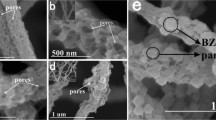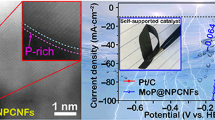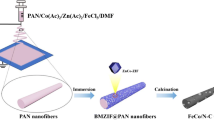Abstract
Electrocatalysis provides an optimal approach for the conversion of carbon dioxide (CO2) into high-value chemicals, thereby presenting a promising avenue toward achieve carbon neutrality. However, addressing the selectivity and stability challenges of metal catalysts in electrolytic reduction remains a daunting task. In this study, the electrospinning method is employed to fabricate porous carbon nanofibers loaded with bismuth nanoparticles with the help of in situ pyrolysis. The porous carbon nanofibers as conductive support would facilitate the dispersion of bismuth active sites while inhibiting their aggregation and promoting the mass transfer, thus enhancing their electrocatalytic activity and stability. Additionally, nitrogen doping induces electron delocalization in bismuth atoms through metal-support interactions, thus enabling efficient adsorption of intermediates for improving selectivity based on the theoretical calculation. Consequently, Bi@PCNF-500 exhibits the exceptional selectivity and stability across a wide range of potential windows. Notably, its faradaic efficiency (FE) of formate reaches 92.7% in H-cell and 94.9% in flow cell, respectively, with good electrocatalytic stability. The in situ characterization and theoretical calculations elucidate the plausible reaction mechanism to obtain basic rules for designing efficient electrocatalyst.
Graphical abstract

摘要
电催化还原是将二氧化碳转化为高价值化学品的理想途径之一,为实现碳中和提供了富有前景的方式。然而,金属催化剂的选择性低和稳定性差是限制电催化转化性能的瓶颈。本研究采用静电纺丝方法与原位热解协同策略制备了负载铋(Bi)纳米颗粒的多孔碳纳米纤维。其中,多孔碳纳米纤维作为导电载体,可有效抑制铋纳米颗粒的聚集,促进活性位点的分散和传质过程,从而实现电催化活性和稳定性的增强。结合理论计算表明,氮掺杂碳载体-金属相互作用可诱导铋原子中的电子离域,从而增强中间体的高效吸附,提高电催化选择性。因此,该Bi@PCNF-500电催剂在宽电位窗口范围内表现出了优异的选择性和稳定性。在H池和流动池中,生成甲酸的法拉第效率可达到92.7和94.9%,且具有良好的电催化稳定性。结合原位表征和理论计算阐明的电催化机理为设计高效电催化剂提供了理论支撑。





Similar content being viewed by others
References
Ceballos BM, Yang JY. Directing the reactivity of metal hydrides for selective CO2 reduction. PNAS. 2018;115(50):12686. https://doi.org/10.1073/pnas.1811396115.
Ren S, Joulié D, Salvatore D, Torbensen K, Wang M, Robert M, Berlinguette CP. Molecular electrocatalysts can mediate fast, selective CO2 reduction in a flow cell. Science. 2019;365(6451):367. https://doi.org/10.1126/science.aax4608.
Zhang X, Sun X, Guo S, Bond AM, Zhang J. Formation of lattice-dislocated bismuth nanowires on copper foam for enhanced electrocatalytic CO2 reduction at low overpotential, Energy Environ. Sci. 2019;12(4):1334. https://doi.org/10.1039/c9ee00018f.
Wang X, Wang Z, García de Arquer FP, Dinh CT, Ozden A, Li YC, Nam D, Li J, Liu YS, Wicks J, Chen Z, Chi M, Chen B, Wang Y, Tam J, Howe JY, Proppe A, Todorović P, Li F, Zhuang TT, Gabardo CM, Kirmani AR, McCallum C, Hung S, Lum Y, Luo M, Min Y, Xu A, Obrien CP, Stephen B, Sun B, Ip AH, Richter LJ, Kelley SO, Sinton D, Sargent EH. Efficient electrically powered CO2-to-ethanol via suppression of deoxygenation. Nat Energy. 2020;5(6):478. https://doi.org/10.1038/s41560-020-0607-8.
Wagner A, Sahm CD, Reisner E. Towards molecular understanding of local chemical environment effects in electro- and photocatalytic CO2 reduction. Nat Catal. 2020;3(10):775. https://doi.org/10.1038/s41929-020-00512-x.
Chen G, Wei F, Zhou Z, Su B, Yang C, Lu XF, Wang S, Wang X. Phase junction crystalline carbon nitride nanosheets modified with CdS nanoparticles for photocatalytic CO2 reduction. Sustain Energ Fuels. 2023;7(2):381. https://doi.org/10.1039/D2SE01576E.
Wang X, Xu A, Li F, Hung SF, Nam DH, Gabardo CM, Wang Z, Xu Y, Ozden A, Rasouli AS, Ip AH, Sinton D, Sargent EH. Efficient methane electrosynthesis enabled by tuning local CO2 availability. J Am Chem Soc. 2020;142(7):3525. https://doi.org/10.1021/jacs.9b12445.
Ma W, Xie S, Liu T, Fan Q, Ye J, Sun F, Jiang Z, Zhang Q, Cheng J, Wang Y. Electrocatalytic reduction of CO2 to ethylene and ethanol through hydrogen-assisted C–C coupling over fluorine-modified copper. Nat Catal. 2020;3(6):478. https://doi.org/10.1038/s41929-020-0450-0.
Zang D, Gao XJ, Li L, Wei Y, Wang H. Confined interface engineering of self-supported Cu@N-doped graphene for electrocatalytic CO2 reduction with enhanced selectivity towards ethanol. Nano Res. 2022;15(10):8872. https://doi.org/10.1007/s12274-022-4698-3.
Zhao Y, Pei Z, Lu XF, Luan D, Wang X, Lou XW. Rationally designed nitrogen-doped carbon macroporous fibers with loading of single cobalt sites for efficient aqueous Zn-CO2 batteries. Chem Catalysis. 2022;2(6):1480. https://doi.org/10.1016/j.checat.2022.05.015.
Xu Q, Jiang J, Wang X, Duan L, Guo H. Understanding oxygen vacant hollow structure CeO2@In2O3 heterojunction to promote CO2 reduction. Rare Met. 2023;42(6):1888. https://doi.org/10.1007/s12598-022-02244-2.
Feng X, Zou H, Zheng R, Wei W, Wang R, Zou W, Lim G, Hong J, Duan L, Chen H. Bi2O3/BiO2 nanoheterojunction for highly efficient electrocatalytic CO2 reduction to formate. Nano Lett. 2022;22(4):1656. https://doi.org/10.1021/acs.nanolett.1c04683.
Yang X, Deng P, Liu D, Zhao S, Li D, Wu H, Ma Y, Xia BY, Li M, Xiao C, Ding S. Partial sulfuration-induced defect and interface tailoring on bismuth oxide for promoting electrocatalytic CO2 reduction. J Mater Chem A. 2020;8(5):2472. https://doi.org/10.1039/C9TA11363K.
Li Y, Chen J, Chen S, Liao X, Zhao T, Cheng F, Wang H. In situ confined growth of bismuth nanoribbons with active and robust edge sites for boosted CO2 electroreduction. ACS Energy Lett. 2022;7(4):1454. https://doi.org/10.1021/acsenergylett.2c00326.
Li L, Zhang Z. Sn–Bi bimetallic interface induced by nano-crumples for CO2 electroreduction to formate. Rare Met. 2022;41(12):3943. https://doi.org/10.1007/s12598-022-02139-2.
Zhang C, Hao X, Wang J, Ding X, Zhong Y, Jiang Y, Wu MC, Long R, Gong W, Liang C, Cai W, Low J, Xiong Y. Concentrated Formic Acid from CO2 Electrolysis for Directly Driving Fuel Cell. Angew Chem Int Ed. 2024;63:e202317628.
Fang W, Guo W, Lu R, Yan Y, Liu X, Wu D, Li FM, Zhou Y, He C, Xia C, Niu H, Wang S, Liu Y, Mao Y, Zhang C, You B, Pang Y, Duan L, Yang X, Song F, Zhai T, Wang G, Guo X, Tan B, Yao T, Wang Z, Xia BY. Durable CO2 conversion in the proton-exchange membrane system. Nature. 2024;626(7997):86. https://doi.org/10.1038/s41586-023-06917-5.
Yang F, Elnabawy AO, Schimmenti R, Song P, Wang J, Peng Z, Yao S, Deng R, Song S, Lin Y, Mavrikakis M, Xu W. Bismuthene for highly efficient carbon dioxide electroreduction reaction. Nat Commun. 2020;11(1):1088. https://doi.org/10.1038/s41467-020-14914-9.
Ren X, Liu F, Wu H, Lu Q, Zhao J, Liu Y, Zhang J, Mao J, Wang J, Han X, Deng Y, Hu W. Reconstructed bismuth oxide through in situ carbonation by carbonate-containing electrolyte for highly active electrocatalytic CO2 reduction to formate. Angew Chem Int Ed. 2024;63(9):e202316640. https://doi.org/10.1002/anie.202316640.
Liu Y, Qiu W, Wang P, Li R, Liu K, Omer KM, Jin Z, Li P. Pyridine-N-rich Cu single-atom catalyst boosts nitrate electroreduction to ammonia. Appl Catal B-Environ. 2024;340:123228. https://doi.org/10.1016/j.apcatb.2023.123228.
Shu X, Chen Q, Yang M, Liu M, Ma J, Zhang J. Tuning co-catalytic sites in hierarchical porous N-doped carbon for high-performance rechargeable and flexible Zn-air battery. Adv Energy Mater. 2022;13(1):2202871. https://doi.org/10.1002/aenm.202202871.
Zhang M, Lu M, Yang M, Liao J, Liu Y, Yan H, Chang J, Li S, Lan Y. Ultrafine Cu nanoclusters confined within covalent organic frameworks for efficient electroreduction of by synergistic strategy,. eScience. 2023;3(3):100116. https://doi.org/10.1016/j.esci.2023.100116.
Ayon SA, Hasan S, Billah MM, Nishat SS, Kabir A. Improved luminescence and photocatalytic properties of Sm3+-doped ZnO nanoparticles via modified sol-gel route: a unified experimental and DFT+U approach. J Rare Earth. 2023;41(4):550. https://doi.org/10.1016/j.jre.2022.03.004.
Liu W, Yuan M, Lian J, Li G, Li QP, Qiao F, Zhao Y. Embedding partial sulfurization of iron-cobalt oxide nanoparticles into carbon nanofibers as an efficient electrode for the advanced asymmetric supercapacitor. Tungsten. 2022;5(1):118. https://doi.org/10.1007/s42864-022-00157-2.
Liu S, Lu XF, Xiao J, Wang X, Lou XW. Bi2O3 nanosheets grown on multi-channel carbon matrix to catalyze efficient CO2 electroreduction to HCOOH. Angew Chem Int Ed. 2019;58(39):13828. https://doi.org/10.1002/anie.201907674.
Tang M, Ding H, Zhang Y, Long Y, Liu J, Jin M, Yi H, Luo L, Lu S, Zhang J. Pt nanoparticles supported on N-doped carbon/mesoporous TiN particle composites as catalysts for the methanol oxidation reaction. ACS Appl Nano Mater. 2024;7(2):1606. https://doi.org/10.1021/acsanm.3c04566.
Liu Q, Liu X, Xie Y, Sun F, Liang Z, Wang L, Fu H. N-Doped carbon coating enhances the bifunctional oxygen reaction activity of CoFe nanoparticles for a highly stable Zn–Air battery. J Mater Chem A. 2020;8(40):21189. https://doi.org/10.1039/d0ta08114k.
Chizari K, Janowska I, Houllé M, Florea I, Ersen O, Romero T, Bernhardt P, Ledoux MJ, PhamHuu C. Tuning of nitrogen-doped carbon nanotubes as catalyst support for liquid-phase reaction. Appl Catal A-Gen. 2010;380(1–2):72. https://doi.org/10.1016/j.apcata.2010.03.031.
Chen Z, Yang W, Wu Y, Zhang C, Luo J, Chen C, Li Y. Atomic iron on mesoporous N-doped carbon to achieve dehydrogenation reaction at room temperature. Nano Res. 2020;13(11):3075. https://doi.org/10.1007/s12274-020-2975-6.
Luo M, Liang Z, Liu C, Qi X, Chen M, Rehman Sagar RU, Yang H, Liang T. Single-atom manganese and nitrogen co-doped graphene as lowcost catalysts for the efficient CO oxidation at room temperature. Appl Surf Sci. 2021;536:147809. https://doi.org/10.1016/j.apsusc.2020.147809.
Li L, Jiang H, Xu N, Lian X, Huang H, Geng H, Peng S. Stable bismuth phosphosulfide nanoparticle encapsulation into hollow multi-channel carbon nanofibers toward high performance sodium storage. J Mater Chem A. 2021;9(32):17336. https://doi.org/10.1039/D1TA05432E.
Li Z, Zhang JT, Chen YM, Li J, Lou XW. Pie-like electrode design for high-energy density lithium-sulfur batteries. Nat Commun. 2015;6(1):8850. https://doi.org/10.1038/ncomms9850.
Wang C, Kim J, Tang J, Kim M, Lim H, Malgras V, You J, Xu Q, Li J, Yamauchi Y. New strategies for novel MOF-derived carbon materials based on nanoarchitectures. Chem. 2020;6(1):19. https://doi.org/10.1016/j.chempr.2019.09.005.
Zhang W, Zhang X, Chen L, Dai J, Ding Y, Ji L, Zhao J, Yan M, Yang F, Chang C, Guo S. Single-walled carbon nanotube induced optimized electron polarization of rhodium nanocrystals to develop an interface catalyst for highly efficient electrocatalysis. ACS Catal. 2018;8(9):8092. https://doi.org/10.1021/acscatal.8b02016.
Liu F, Liu S, Meng J, Xia F, Xiao Z, Liu Z, Li Q, Wu J, Mai L. Stabilizing conversion reaction electrodes by MOF derived N-doped carbon shell for highly reversible lithium storage. Nano Energy. 2020;73:104758. https://doi.org/10.1016/j.nanoen.2020.104758.
Cheng X, Ran F, Huang Y, Zheng R, Yu H, Shu J, Xie Y, He YB. Insight into the synergistic effect of N, S Co-doping for carbon coating layer on niobium oxide anodes with ultra-long life. Adv Funct Mater. 2021;31(19):2100311. https://doi.org/10.1002/adfm.202100311.
Yao P, Li T, Qiu Y, Zheng Q, Zhang H, Yan J, Li X. N-doped hierarchical porous carbon derived from bismuth salts decorated ZIF-8 as a highly efficient electrocatalyst for CO2 reduction. J Mater Chem A. 2021;9(1):320. https://doi.org/10.1039/d0ta09293b.
Liu Z, Zhang J, Yu L, Wang H, Huang X. Thermal derived bismuth nanoparticles on nitrogen-doped carbon aerogel enable selective electrochemical production of formate from CO2. J CO2 Util. 2022;61:102031. https://doi.org/10.1016/j.jcou.2022.102031.
Chen Q, Chen S, Ma J, Ding S, Zhang J. Separation effect of graphene sheets with N, O codoping and molybdenum clusters for reversible lithium-iodine batteries. Adv Funct Mater. 2023;34(2):2308272. https://doi.org/10.1002/adfm.202308272.
Li H, Liu M, Zhao C, Le Z, Wei W, Nie P, Hou M, Xu T, Gao S, Wang L, Chang L. Highly dispersed antimony-bismuth alloy encapsulated in carbon nanofibers for ultrastable K-Ion batteries. J Phys Chem Lett. 2022;13(28):6587. https://doi.org/10.1021/acs.jpclett.2c01032.
Liu X, Zhu Y, Ye H, Chen J, Zhang L, Wei H, Liu Z, Qian Y. Controlled tin oxide nanoparticles encapsulated in N-Doped carbon nanofibers for superior lithium-ion storage. ACS Appl Energy Mater. 2022;5(2):1840. https://doi.org/10.1021/acsaem.1c03268.
Cao X, Tian Y, Ma J, Guo W, Cai W, Zhang J. Strong p-d Orbital hybridization on bismuth nanosheets for high performing CO2 electroreduction. Adv Mater. 2024;36(6):2309648.
Deng P, Wang H, Qi R, Zhu J, Chen S, Yang F, Zhou L, Qi K, Liu H, Xia BY. Bismuth oxides with enhanced bismuth-oxygen structure for efficient electrochemical reduction of carbon dioxide to formate. ACS Catal. 2019;10(1):743. https://doi.org/10.1021/acscatal.9b04043.
Xu Y, Guo Y, Sheng Y, Yu H, Deng K, Wang Z, Li X, Wang H, Wang L. Selective CO2 electroreduction to formate on polypyrrole-modified oxygen vacancy-rich Bi2O3 nanosheet precatalysts by local microenvironment modulation. Small. 2023;19(29):2300001. https://doi.org/10.1002/smll.202300001.
Gan R, Song Y, Ma C, Shi J. In situ growth of N-doped carbon nanotubes in Fe-Nx/Fe2O3/Fe3O4-encapsulated carbon sheets for efficient bifunctional oxygen catalysis. Appl Catal B-Environ. 2023;327:122443. https://doi.org/10.1016/j.apcatb.2023.122443.
Shi M, Lu K, Hong X, Qiang H, Liu C, Ding Z, Wang F, Xia M. High-yield green synthesis of N-doped hierarchical porous carbon by nitrate-mediated organic salt activation strategy for capacitive deionization: universality and commerciality. Chem. Eng. J. 2023;471:144465. https://doi.org/10.1016/j.cej.2023.144465.
Jiang H, Luo R, Li Y, Chen W. Recent advances in solid-liquid-gas three-phase interfaces in electrocatalysis for energy conversion and storage. EcoMat. 2022;4(4):12199. https://doi.org/10.1002/eom2.12199.
Iglesias van Montfort H, Subramanian S, Irtem E, Sassenburg M, Li M, Kok J, Middelkoop J, Burdyny T. An advanced guide to assembly and operation of CO2 electrolyzers. ACS Energ. Lett. 2023;8:4156.
Gorthy S, Verma S, Sinha N, Shetty S, Nguyen H, Neurock M. Theoretical insights into the effects of KOH concentration and the role of OH– in the electrocatalytic reduction of CO2 on Au. ACS Catal. 2023;13(19):12924. https://doi.org/10.1021/acscatal.2c06115.
Duan Y, Liu K, Zhang Q, Yan J, Jiang Q. Efficient CO2 reduction to HCOOH with high selectivity and energy efficiency over Bi/rGO catalyst. Small Methods. 2020;4(5):1900846. https://doi.org/10.1002/smtd.201900846.
Huang X, Lin J, Liang J, Kou E, Cai W, Zheng Y, Zhang H, Zhang X, Liu Y, Li W, Lei B. Pyridinic nitrogen doped carbon dots supply electrons to improve photosynthesis and extracellular electron transfer of chlorella pyrenoidosa. Small. 2023;19(31):2206222. https://doi.org/10.1002/smll.202206222.
Ning X, Li Y, Dong B, Wang H, Yu H, Peng F, Yang Y. Electron transfer dependent catalysis of Pt on N-doped carbon nanotubes: effects of synthesis method on metal-support interaction. J Catal. 2017;348:100. https://doi.org/10.1016/j.jcat.2017.02.011.
Cao X, Wulan B, Zhang B, Tan D, Zhang J. Defect evolution of hierarchical SnO2 aggregates for boosting CO2 electrocatalytic reduction. J Mater Chem A. 2021;9(26):14741.
Firet NJ, Smith WA. Probing the reaction mechanism of CO2 electroreduction over Ag films via operando infrared spectroscopy. ACS Catal. 2016;7(1):606. https://doi.org/10.1021/acscatal.6b02382.
Jia B, Chen Z, Li C, Li Z, Zhou X, Wang T, Yang W, Sun L, Zhang B. Indium cyanamide for industrial-grade CO2 electroreduction to formic acid. J Am Chem Soc. 2023;145(25):14101. https://doi.org/10.1021/jacs.3c04288.
Acknowledgements
This work was financially supported by the National Natural Science Foundation of China (Nos. 22175108 and 22379086), the Natural Science Foundation of Shandong Province (Nos.ZR2020JQ09 and ZR2022ZD27) and Taishan Scholars Program of Shandong Province (tstp20221105). The authors also acknowledge the assistance of the Analytical Center for Structural Constituent and Physical Property of Core Facilities Sharing Platform, Shandong University.
Author information
Authors and Affiliations
Corresponding author
Ethics declarations
Conflict of interests
The authors declare that they have no conflict of interest.
Supplementary Information
Below is the link to the electronic supplementary material.
Rights and permissions
Springer Nature or its licensor (e.g. a society or other partner) holds exclusive rights to this article under a publishing agreement with the author(s) or other rightsholder(s); author self-archiving of the accepted manuscript version of this article is solely governed by the terms of such publishing agreement and applicable law.
About this article
Cite this article
Guo, WJ., Zhou, A., Cai, WW. et al. In situ embedded bismuth nanoparticles among highly porous carbon fibers for efficient carbon dioxide reduction. Rare Met. (2024). https://doi.org/10.1007/s12598-024-02803-9
Received:
Revised:
Accepted:
Published:
DOI: https://doi.org/10.1007/s12598-024-02803-9




